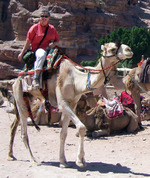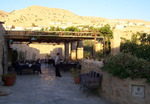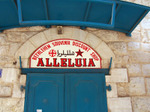Six months before his 50th birthday, my old friend Thomas announced very matter-of-factly that he wanted to take some of his favorite people, including me, on a pilgrimage to celebrate the occasion. He is one of the most generous people in the world. We are often on the same wavelength, and so to me, everything seemed instantly clear. "Paris!" I yelped. I started scrabbling through my Rolodex. "I should start booking restaurants now."
"Well, no," he said. "I want to go on a real pilgrimage. To the Holy Land. I want to be there on my birthday."
"That's in July." Silence. "It's going to be hot. Extremely hot."
The silence turned a little mulish. "You're a daughter of the South," he said. "You're used to it."
So that is how I found myself a world away, sitting on a camel and consumed with delight, padding through the Roman arch at Petra, through the sandstone gorges lined with tombs, through the magnificent, brooding ruins of a lost empire. More than 2,000 years ago, this was the capital of the kingdom held by the Nabataean Arabs, masters of the spice caravans. I had bought a small, dark-golden lump of frankincense the night before and had fingered it thoughtfully all day. We had heard the muezzin call the dawn prayer, seen the sun rise over the desert, and spent the early morning crisscrossing Petra's vast central plain, climbing flights of rock-hewn steps to reach monuments hidden high in steep, shadowy ravines. Cecil B. DeMille would have coveted their stagy but undeniable grandeur: The Nabataeans were the magpies of the ancient world, plucking architectural elements (and architects) everywhere from Arabia to the Mediterranean. My companions (there were six of us in all, and we'd known one another forever) decided to hike the distance back to the famous Siq, but I'd had enough. There's nothing more fun to me than going fast, and I was curious to see whether my ride could keep up with one of the beautiful little Arabian mares that had just whirled by. So I kicked my camel into a run, and we were off in a cloud of dust.

One of the best things about Petra, we agreed after our two days there, was staying at Taybet Zaman, a secluded mountain lodge about a 15-minute twisty drive from the archaeological site. It was once part of a Jordanian village that was deserted by its inhabitants in the 1960s. A former mayor suggested turning it into a hotel, and so buildings have been recycled into guest quarters furnished with Bedouin textiles in addition to all the accoutrements fancied by Westerners. Locals own and run the place, which includes a Turkish bath, a jewel of a pool, and a small souk, where pottery, textiles, and other artisanal crafts are made on-site.
In the cool of the evening, we ate our meal on a veranda set underneath a grape arbor. An enormous and perfectly full orange moon rode low in the sky over scrubby mauve hills. The air smelled of wood smoke. Everything was delicious, and we ate it all: freekeh soup—crushed barley and shredded chicken in an intense, chickeny broth; mezes that included tomato and cucumber salad; pickled carrots and celery and baby okra; little cheesy phyllo triangles; kibbe; silky hummus; eggplant salad made simultaneously sweet and sharp by tomato and citrus; and a tabbouleh that was essentially a sparkling-fresh parsley salad merely dotted with bulgur instead of the grain-heavy dish you normally find in the States. I was reminded that parsley is treated as a vegetable in the Middle East, and what an intelligent idea that is. We ordered more wine, caught our breath, and moved on to the mixed grill—chicken shashlik, lamb chops, and well-seasoned kebabs—and succulent chunks of lamb cooked with yogurt in a stew and served with saffron rice. Then we sat there, sipping our glasses of mint tea and gazing at the moon. "Back to Jerusalem tomorrow," someone said quietly.
That was where we had started our tour, of course, and no matter how you feel about religion, like all ancient cities it is haunted and heartbreaking. By the time we returned from Petra, things between Israel and Hezbollah had gotten very ugly indeed. Press and U.N. personnel were pouring into our hotel, the American Colony, and we were in the thick of things, which always makes me feel secure—forget the CNN channel; I'd rather have a drink with the reporter just in from Gaza whom I met in the hotel's unbelievably great bookshop. We had access to information from all points, and we took our cues from the people on the street: Life goes on. And being variously from New York City, Washington, DC, and New Orleans, we got the picture.
Here are some of our favorite things in Jerusalem and beyond. It's a very personal list and a pinhole view of a place with a great deal of metaphysical heft. We hope you go sometime.

Religious Sites
The Western Wall, the Dome of the Rock, and the church of the Holy Sepulchre are all astonishing and gratifying in their own ways. (One of my companions found the wall so powerful that he went back again and again. My other female companion and I had a different experience when shunted off to the women's section: We felt like second-class citizens.) Rather more off the beaten path is the church of Saint Mark (in the Armenian Quarter), the center of the tiny but valiant Syrian Orthodox community, whose services are conducted in Aramaic. Tradition has it that the building covers the house of Mary, Mark's mother; Saint Peter came here when he was released from prison by an angel (see the Rembrandt in the Israel Museum); the Virgin Mary was baptized here; and the Last Supper was eaten here. This is all of dubious authenticity, but the place has its own mystical reality. If you are lucky, a tiny woman dressed in black will show you the extraordinarily beautiful icon of Mary that hangs above the font. It is in the darkest corner of the dimly lit church, and the guide will light two long tapers and hold them up to dramatically illuminate the painting. Mesmerizing stuff, and you will either run screaming out into the street or be rocked back on your heels. A less debatable call from a historical point of view is the serene Garden of Gethsemane, on the Mount of Olives. The Mount of the Beatitudes, up on the Lake of Galilee, is even more contemplative; its tranquility is a balm to the weariest of travelers. The Church of the Nativity, in Bethlehem, was built by Constantine over the grotto where Jesus is said to have been born. "Bethlehem is charming and moving and strange," wrote Rose Macauley in The Towers of Trebizond. "I like the dark cavern glittering with silver lamps and gold and silver and tinsel ornaments and smoky incense fumes." She could have written that yesterday instead of in 1956. Mount Nebo, in Jordan, is one of the world's most powerful, primal, ancient liturgical sites. This is where the Moses saw the Promised Land stretching down toward the River Jordan and the Dead Sea. The landscape remains essentially unchanged, and if you have any imagination at all, you can easily transport yourself back 2,000 years. Read Martin Luther King Jr. as well as Deuteronomy while standing on the windy outcrop.
Museum Highlights
The Rockefeller Museum, built in 1927, houses archaeological treasures from the region, from eras ranging from the Stone Age to the 18th century. It's pretty great, and everything you want in a museum: beautiful objects in beautiful cases in beautiful rooms. A look at the outdoor model of Jerusalem in the Late Second Temple Period at the Israel Museum is a useful way to get your bearings before diving into the alleyways of the Old City. On view until January 15 is "Bread: Daily and Divine," which brings together the three monotheistic religions on a very human scale. The Judaica, ethnographic, and archaeological collections (which include the Dead Sea Scrolls) are superb; in terms of paintings, don't miss Rembrandt's St. Peter in Prison and Poussin's Destruction and Sack of the Temple of Jerusalem.
Where to Eat
The Machane Yehuda Market (what locals simply call the Shuk), in Jerusalem's New City, spills over with alluring mounds of spices, dates, crystallized kumquats, olives, cheeses, nuts, coffee (Israel is the only country in which Starbucks has failed), splintery blocks of halvah, and, from the Yemenite Healer, juice blends (etrog and gat, anyone?) for mind and body. We made the rounds before stopping at a little shuk bistro called Tzachko (02-623-4916) for lunch, where offerings include seared eggplant with tahini, preserved lemons, garlic, and hyssop; sauteéed Saint Peter's fish (a.k.a. tilapia; it's farmed up in the Galilee, naturally enough); and spicy-sweet chicken wings.
One of the best hummus places in the Muslim Quarter is Abu Shukri (63 Al Wad Rd., next to the Damascus Gate): not fancy, but fresh and fast and very welcoming. If you're in the mood for something more substantial—a mixed grill, for instance, or "lasagne," actually more of a moussaka assembled with delicate handmade pasta—head to the Armenian Tavern (Armenian Orthodox Patriarchiate Rd. #79; 02-627-3854). It's filled with some terrific Armenian pottery, textiles, and cases of jewelry (everything has its price).
For dinner, we also ate very simply and very well. Pasha's (28 Pier Koenig St.; 02648-2220), a ten-minute walk away from the American Colony, is lively and served a vast, satisfying spread of Turkish salads and grilled meats (if you love chicken livers, order them here). It is one of several similar small and unpretentious restaurants on the block; when we were there, they were all crowded with press and NGOs. We loved the tagines and couscous at Darna (3 Horkanos St.; 02-624-5406), a very stylish Moroccan restaurant popular with the locals. Call for a cab before you pay the bill, though, or you might have to wait for one. (Alternative plan, which worked for us: Turn right at the restaurant's doorway and make another right at the corner; walk down the street to the major thoroughfare and hop in a cab there.) Our one fancy night out, in honor of Thomas's birthday, was spent at Canela (8 Shlomzion HaMalka St; 02-622-2293). The quiet, confident hand of chef Marcus Gerkovitz was present in every dish: Seared foie gras drizzled with date syrup, tuna tartare layered with paper-thin slices of crisp vegetables and caressed with a beautifully balanced dressing, and wild bass poached in olive oil and served with tomato confit and preserved lemon were standouts.
What You'll Need
- A sun hat that can be easily stuffed into a shoulder bag
- Empty Ziploc bags in various sizes
- A tiny headlamp on a removable elastic band for poking around in dark grottoes (we found ours at Campmor for about $20)
- Small, lightweight binoculars
- Light wrap for evenings (they are cool)
- Energy bars
Tips on Getting Through the Tel Aviv Airport
Things were on (very) high alert when we were there, but in retrospect, we were probably in the safest airport in the world. Upon entering, don't panic when you look at the big board that lists arrivals and departures: The Hebrew will change to English if you wait just a moment. It took us every bit of three hours to go through security, but the staff was calm, patient, polite, and very, very thorough.
Favorite Reads—For Before, During, or After a Trip to the Middle East
Petra and the Lost Kingdom of the Nabataeans by Jane Taylor
(you might not want to take this with you because it's heavy, but it's packed
with great information and gorgeous photographs)
The Holy Land by Jerome Murphy-O'Connor (this Oxford
Archaeological Guide covers more than 200 sites and includes maps and
photographs)
Walking the Bible, Abraham, and Walking
With God by Gourmet contributing editor Bruce Feiler (these books
reflect his life as a traveler through the heart of the Middle East)
Palestine & Palestinians by the Alternative Tourism Group
(of great interest if you take a side trip to Bethlehem)
Travels with a Tangerine: From Morocco to Turkey in the Footsteps of
Islam's Greatest Traveler by Tim Mackintosh-Smith (for anyone who ever
wanted to be an explorer when they grew up)
The Towers of Trebizond by Rose Macauley (a masterpiece)
Quarantine by Jim Crace (if you love intense, imaginative,
profound novels)
Drinking the Sea at Gaza by Amira Hass (passionate and
observant; from the first Israeli journalist to live in the Palestinian enclave)

